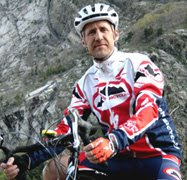
The Maicos of the early 1970s were some of the best motocross bikes you could buy at the time, the competition being bikes like Bultaco, CZ, Husqvarna, Penton (KTM), early Japanese models and others. All motorcycles from that era had flaws and limitations, but the Maicos were good all-arounders — with a tractable powerband, good handling, cool machined aluminum parts, and the legendary Maico forks.
As the 1970s progressed, the European brands pretty much kept pace with the fast-moving Japanese onslaught, albeit on more of a 2- or 3-year design cycle rather than a yearly one like Honda, Suzuki, Yamaha, and Kawasaki practiced. Long travel suspension went from 6 inches in the early 1970s to 10.5 inches by 1978. Lots of bikes had long travel, but the trick was to get the good handling and sharp cornering of the older, lower bikes combined with effective long travel.
Enter the 1978 Maico 250 Magnum. Maico had done a complete redesign of their motocross bikes for 1978, using features and parts that were just like the factory works bikes of Germans Herbert Schmitz, Adolf Weil, and Hans Maisch (son of the owner of the Maico factory "MAIsch-CO"). We had seen the factory Maicos up close and personal, on a post-high school graduation trip to Sears Point in Northern California to see the fall Trans-Am race. All the big heroes were there, the most electrifying being the cool Belgian, Roger DeCoster. Just his presence was enough to render 4 moto-crazy high school kids speechless and stupid.
We were all witness to much lawlessness and frivolity on this trip, but one lasting memory is seeing the Maico team that was there with American factory riders Steve "Short Stack" Stackable, and "Gassin'" Gaylon Mosier. Stackable rode a good race in the 500cc International class against some of the fastest riders in the world that day, but I will never forget the ride Mosier put in to hold off wild-riding Bob "Hurricane" Hannah in the 2nd moto. Both riders were swapping around the steep course, skidding in all the off camber corners and deflecting off every rut and bump. Hannah was closing fast, but Mosier turned the throttle wide open and executed some wild riding of his own to barely hold off Hannah at the flag.
The Maico I bought from Don Gibbs at Utah Sportcycle was for all intents and purposes the same bike ridden by the factory riders. At least the basic castings, frame dimensions, engine basics (excluding modifications like porting or boost ports) and most parts were the same. It had an all-new engine that featured some of the smallest engine cases we had ever seen. The clutch was housed in a compact, sand-cast side case, and used a double-row chain to transfer power. It used a piston port top end with radial cooling fins on the head, like the old Maicos.
The red frame was cromoly steel tubing, welded up in a double cradle configuration which allowed the exhaust to exit directly from the front of the cylinder, a feature that was thought to give more power. It had a banana-shaped steel swingarm that allowed the shocks to give long travel in the back with the bike sitting lower for better cornering and handling. The countershaft sprocket was positioned very close to the swingarm pivot, allowing for less free play in the final drive chain. This was a great solution to a problem with early long-travel bikes: the dreaded chain slap.
The famous Maico forks graced the front, the same sand-cast aluminum, leading-axle lowers as the earlier Maicos but with 10.5 inches of travel, machined triple clamps, and upsized 38mm tubes. The shocks were Corte Cossa (an Italian brand) and had remote reservoirs intended to provide extra cooling capacity for the hard-working dampers. A works replica lightweight aluminum gas tank, painted red to match the rest of the bike, some solid looking sand-cast aluminum conical hubs, Metzeler tires, and lots of machined pieces made for one cool bike.
The 1978 Maico was a very fast 250. One thing that helped hard acceleration was the fact that you could just shift through the gears without letting off the throttle or using the clutch. The shift lever, if nudged at the right RPM, would snick into the next highest gear with no hesitation or loss of forward momentum. The turning was exceptionally predictable and the bike could skate around corners faster than anything else at the time. Good stuff.
The magic of the 1978 Maico Magnum was that it melded the old handling traits, cottage industry feel, and raw-hewn "works" parts with the advanced performance being achieved by technology's march. In a time of rapid changes, Maico was defiant of the inevitable—at least for a few great years—before succoming to the tides of change and economics.

2 comments:
Maicos were super cool. Some of my old pals rode Maicos back then. One on a 250 just like yours.
Another pal had a '75 Maico 400, then later a '79 Maico 450.
Very trick stuff for the time.
MX pals used to head over to Unidilla to watch the 250 GP. Bob Hannah, Kent Howerton, Marty Tripes, etc..
Great stuff.
Post a Comment